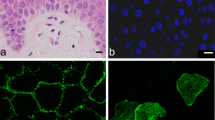Summary
Hemidesmosomes of the skin are adhesive structures involved in the anchoring of the epidermis to structures of the basement membrane and the underlying dermis. The plasma membrane of the basal cells is an integral component of hemidesmosomes. This freeze fracture study shows the intramembranous changes that occur during hemidesmosome formation in the epidermis during human embryonic/fetal development. The first indication of hemidesmosomes is the presence of groups of intramembranous particles on the E fracture face of basal cells. Each group of intramembranous particles represents a hemidesmosome. With progressive development the number of intramembranous particles per hemidesmosome and the number of hemidesmosomes increases. Concomitant with these changes the plasma membrane bows toward the dermis at the hemidesmosome sites. The distribution of hemidesmosomes in the plane of the basal plasma membrane is non-uniform with the majority found in the center. The outline of the hemidesmosomes is variable although the elongate shape is the most common.
Similar content being viewed by others
References
Breathnach AS, Stolinski C, Gross M (1972) Ultrastructure of foetal and postnatal human skin as revealed by the freeze-fracture replication technique. Micron 3:287–304
Briggaman RA (1982) Biochemical composition of the epidermaldermal junction and other basement membranes. J Invest Derm 78:1–6
Briggaman RA, Wheeler CE (1975) The epidermal-dermal junction. J Invest Derm 65:71–84
Briggaman RA, Dalldorf F, Wheeler CE (1971) Formation and origin of basal lamina and anchoring fibrils in adult human skin. J Cell Biol 51:384–395
Buck RC (1982) Hemidesmosomes of normal and regenerating mouse corneal epithelium. Virchows Arch [B] 41:1–16
Buck RC (1983) Ultrastructural characteristics associated with the anchoring of corneal epithelium in several classes of vertebrates. J Anat 137:743–756
Caputo R, Peluchetti D (1977) The junctions of normal human epidermis. A freeze-fracture study. J Ultrastr Res 61:44–61
Ellison J, Garrod DR (1984) Anchoring filaments of the amphibian epidermal-dermal junction traverse the basal lamina entirely from the plasma membrane of hemidesmosomes to the dermis. J Cell Sci 72:163–172
Gipson IK, Grill SM, Spurr SJ, Brennan SJ (1983) Hemidesmosome formation in vitro. J Cell Biol 97:849–857
Holbrook KA, Smith LT (1981) Ultrastructural aspects of human skin during the embryonic, fetal, premature, neonatal, and adult periods of life. Birth Defects 17:9–38
Karnovsky MJ (1971) Use of ferrocyanide reduced osmium in electron microscopy. Proc Annu Meet Am Soc Cell Biol, p 146
Kelly DE, Kuda AM (1981) Traversing filaments in desmosomal and hemidesmosomal attachments: freeze-fracture approaches toward their characterization. Anat Rec 199:1–14
Leloup R, Laurent L, Ronveaux MF, Drochmans P, Wanson JC (1979) Desmosomes and desmogenesis in the epidermis of calf muzzle. Biol Cell 34:137–152
Luft JH (1961) Improvements in epoxy resin embedding methods. J Biophys Biochem Cytol 9:409–414
Riddle CV (1984) Development of hemidesmosomes in fetal epidermis. J Cell Biol 99:401a
Shienvold FL, Kelly DE (1976) The hemidesmosome: new fine structural features revealed by freeze-fracture techniques. Cell Tissue Res 172:289–307
Shimono M, Clementi F (1976) Intercellular junctions of oral epithelium. I. Studies with freeze-fracture and tracing methods of normal rat keratinized oral epithelium. J Ultrastruct Res 56:121–136
Smith LT (1985) The development of dermal connective tissue in human embryonic and fetal skin. Doctoral thesis, University of Washington
Staehelin LA, Hull BE (1978) Junctions between living cells. Sci Am 238:140–152
Susi FR, Belt WD, Kelly DE (1967) Fine structure of fibrillar complexes associated with the basement membrane in human oral mucosa. J Cell Biol 34:686–690
Vail WJ, Stollery JG (1978) A convenient method to remove lipid contamination from freeze fracture replicas. J Micros 113:107–108
Author information
Authors and Affiliations
Rights and permissions
About this article
Cite this article
Riddle, C.V. Development of hemidesmosomes: an intramembranous view. Anat Embryol 174, 153–160 (1986). https://doi.org/10.1007/BF00824330
Accepted:
Issue Date:
DOI: https://doi.org/10.1007/BF00824330




